
Historicamente, os mofos naturais disponíveis no ambiente eram responsáveis pela colonização dos produtos curados e os efeitos positivos desses mofos no aroma, textura e preservação foram constatados. O desempenho inconsistente destas sepas selvagem levou à inoculação intencional ou culturas starter para obter uma qualidade uniforme dos produtos finais – especialmente uma cobertura branca e uniforme evitando as falhas do produto causadas por infestação nociva.
O mercado de produtos carneos fermentados tem aumentado durante as últimas décadas e a explicação está no sabor e aroma superiores frente aos não fermentados. O uso de culturas starter traz ganhos e controle sobre a produção. Ela protege a superfície e reduz a ocorrência de endurecimento do exterior do produto(dry rim ou case hardening). Além disso, através da atividade proteolítica e lipolítica (degradação enzimática de proteínas e gorduras), influencia positivamente na maturação da carne e proporciona textura mais macia.
As culturas starter mais utilizados atualmente para inocular o mofo em salames, copas e outros produtos cárneos fermentados são muitas, como a Mold-600, Mold-800, Lyocarni e Lallemand Penicilium Nalgiovense A mold-600, Lyocarni e Lallemand contém o Penicillium Nalgiovense, já a mold-800 contém Penicillium candidum e Penicillium nalgiovense.
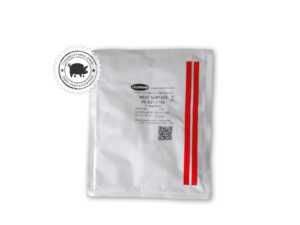
Vantagens atribuidas à cultura fúngica intencional
- Reduz o surgimento do “dry rim” ou “Case hardening”;
- Melhora a coloração do produto;
- Textura mais uniforme em todo o produto;
- Tempo de secagem reduzido;
- Pela ação proteolítica e lipolítica.

Culturas
Lallemand Penicilium Nalgiovense – PS-521
Penicillium nalgiovense
– Crescimento rápido e supressão de floras selvagens;
– Cobertura densa e uniforme;
– Cobertura branca tradicional;
– Sabor pronunciado de cogumelos.
MOLD-600
Penicillium nalgiovense
– Crescimento rápido e supressão de floras selvagens;
– Cobertura densa e uniforme;
– Cobertura branca tradicional;
– Sabor pronunciado de cogumelos.
MOLD-800
Penicillium candidum e Penicillium nalgiovense
– Crescimento rápido e supressão de floras selvagens;
– Cobertura densa e uniforme;
– Aroma leve de camembert / Sabor forte de cogumelos e um aroma típico de musgo;
– Maior potencial de crescimento em ambientes instáveis(temperatura e umidade).
Como usar
Dosagem
Como regra geral: 25g de cultura para 10 litros de água
Fatores de crescimento mais importantes
O crescimento deve aparecer dentro de 2 dias(pontos redondos brancos). Os mofos crescem de forma irregular, portanto é muito importante obter uma distribuição uniforme dos esporos. Se as condições de crescimento forem adversas (frio, ventilação forte, seco), os esporos podem crescer muito devagar e haver grandes manchas sem cobertura e mofos selvagens podem surgir.
Tipo de produto: A proporção de gordura e carne magra determina a transferência de umidade para o invólucro e, portanto, as condições de crescimento do mofo. Áreas com mais ou menos gordura modificam a evaporação, tornando regiões mais e menos favoráveis ao mofo.
Tripa de Celulose: Não é a ideal por ter superfície seca. Deve ser umedecida antes. O crescimento leva mais tmepo do que em tripas naturais. Alguns mofos reagem com a celulose e podem criar buracos.
Tripa de Colágeno: Potencial de crescimento inferior à tripa natural mas superior à tripa de celulose.
Tripas naturais: Devem ser bem limpas antes do uso. É ótima para obter uma cobertura perfeita e densa do produto. Em alguns casos pode ser necessário um controle mais rigoroso do crescimento para evitar um crescimento excessivo do mofo.
Fermentação: O sucesso do mofo depende da boa regulação da umidade, que pode ser usada para estimular ou inibir o crescimento do mofo. Além disso, requer ajuste da velocidade do ar e controle de temperatura.
Regra geral
- Umidade ideal para o crescimento > 90%;
- Circulação de ar deve ser moderada a baixa;
- A temperatura deve estar entre 24–30°C.
Umidade: Se a diferença entre a umidade do ar e do produto for muito grande a evaporação pode ser excessiva ocasionando um produto seco por fora. Exterior seco inibe o desenvolvimento dos esporos.
Temperatura: Temperaturas acima de 24°C produzem bom desenvolvimento dos esporos. Temperaturas inferiores reduzem a velocidade de crescimento e temperaturas muito baixam impedem o desenvolvimento. A temperatura não deve exceder 30°C.
Circulação de ar: Deve ser baixa no início (0.1 a 0.2 m/s) e não deve ultrapassar 0.6 m/s. Velocidades elevadas são usadas para criar uma crosta nos produtos e velocidades muito baixas reduzem a perda de umidade. A ventilação de ar fresco(externo) deve preferencialmente passar por filtros para evitar contaminação.
Aplicação
Mergulhar o produto: A água deve ser constantemente mechida para evitar o depósito dos esporos no fundo do recipiente. O produto deve ser totalmente submerso.
Borrifar: O produto deve ser mantido em movimento e virado constantemente.
Problemas comuns
Cobertura esverdeada
– Mofo selvagem suprimiu a cultura starter;
– Ocorreram proleferações adicionais descontroladas.
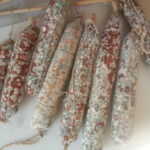
Muco
– Contaminação do ambiente;
– Contaminação proveniente de manipulação ou da tripa.
Surgimento de culturas selvagens
– Existência de colônias no ambiente;
– Circulação de ar contaminado, sem filtros.
Mofo não cobriu o produto
– Outra colonia matou a cultura starter inoculada;
– Camada de bactérias impede que o mofo se prenda na tripa.
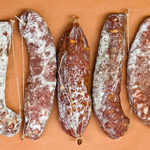
Cobertura do mofo muito intensa
– Umidade muito elevada;
– Tripas naturais não foram limpas corretamente;
– Umidade alta por período muito longo.
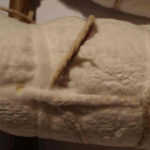
Cobertura do mofo muito fraca
– Pouca umidade durante o período inicial de fermentação;
– Ventilação muito alta;
– Temperatura muito baixa.
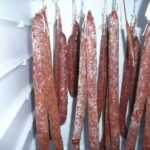
Mofo selvagem cobriu o inoculado
– Remover todo o mofo natural antes de aplicar a cultura starter;
– Contaminação da ventilação externa;
– Condição incorreta para o crescimento da cultura starter;
– Fermentação e secagem incorretas.
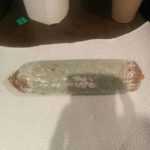
Aroma de “amônia” muito forte
– Excesso de Penicillium Candidum;
– Ciclo de fermentação e secagem matou a cultura starter. Mofo morrendo produz mais amônia;
– Use mais penicillium nalgiovense.
Superfície pegajosa
– Contaminação bacteriana;
– Fermentação incorreta, secagem tardia;
– Tripas com problemas;
– Má ou falta de ventilação.
Fonte: CHR-Hansen
Vídeo sobre o uso do penicilium nalgiovense




Bom dia, posso utilizar para qualquer curado? copa, presunto, lombo, etc? outra duvida, se o produto ja esta contaminado preciso lavar como e com que antes de colocar a nova cultura?
obrigado
Sim, pode utilizar em qualquer curado/maturado. Se o produto já estiver com mofo, o ideal é trocar a tripa ou limpar bem escovando ou esfregando a peça com água corrente e depois aplicar a cultura.
Bom dia. Comprei um pacote de MOLD 600 e não coloquei no freezer mas também não abri ainda. Tem uns 7 dias. Ainda presta? Ou perdi a cultura?
Oi Luan, a cultura mold aguenta por volta de 15 dias fora do congelador, pode usar, muito provavelmente ela está boa.
Produzi o salame com adição de vinho (para acidez) e sal de cura dentro da especificações. Optei por usar o pinicillium candida (Brie), pois foi mais fácil encontrar. Apliquei com borrifador por dois dias apenas e o copa e o salame já adquiriram uma aparência aveludada e bem distribuída na superfície dos produtos. Recentemente fiz uma limpeza de alguns fungos nativos que estavam proliferando e estão bem apresentáveis, mas tenho duas dúvidas quanto ao aspecto e cheiro.
Como nunca havia utilizado o penicillium me espantei com a velocidade e quantidade de fungo produzidos em tão pouco tempo. O fungo tem boa aparência (camada branca aveludada), mas pela grande quantidade não sei se está correto. Outra questão é o cheiro de amônia. Isso é normal, devo fazer algo quando exala esse cheiro?
Oi Homero. O penicillium candidum tem essa característica de formar uma camada bem espessa quando as condições são favoráveis, como vemos no queijo brie, fica bem bonito. O cheiro também é algo que pode ocorrer pela presença forte do fungo. Um sabor levemente amargo também. Caso queira, respe um pouco da cobertura para reduzir a quantidade, deve ajudar a diminuir o cheiro e o possível sabor que deixe nos salames.
Boa tarde! Quando o salame tiver atingido a perda de peso alvo posso embalar à vácuo com a cobertura o MOLD? As peças estão todas brancas e gosto muito dessa aparência, mas ouvi dizer que no vácuo eles morreriam. Acontece que já comprei um saucisson francês no vácuo todo coberto com o fungo uma vez e estava ótimo…
Oi Marcos, os fungos irão morrer mas a cobertura que já foi criada permanecerá. Só não haverá proliferação posterior devido ao ambiente anaeróbico. Nunca li algum estudo que cite esse impedimento de selar a vácuo com o fungo.
Boa tarde, posso proceder da mesma forma para armazenar o bactoferm no congelador assim como o mold apos aberto.
Boa tarde, gostaria de saber se posso armazenar a cultura starter na geladeira, eu comprei um envelope e utilizei somente uma pitada para dissolver em 100ml para borrifar. Outra pergunta, esse liquido, posso guardar por quanto tempo? Pode ser na geladeira? Agradeço!
Oi Ernesto, armazene o pó no envelope original, bem fechado, dentro do congelador. Sobre o líquido com a pitada de cultura já dissolvida infelizmente não há como aproveitar, o melhor é descartar após no máximo umas duas horas. Um uso para esse excesso é borrifar ou esfregar nas paredes do local onde vai deixar os produtos pendurados. O ambiente também ajuda a transferir os fungos para os produtos.
Muito obrigado! Wu abri a embalagem, da cultura, no sábado passado e havia guardado na geladeira. Transferi hoje para o congelador, será que perdi? Agradeço!
Oi Ernesto. Sem problemas, as culturas do tipo mold(fúngicas) tem ótima durabilidade e suportam muito tempo fora da temperatura ideal. Os fungos são muito, mas muito resistentes. Nas próximas aplicações verá que muito provavelmente o fungo prosperará da mesma forma. Abraços!
Eduardo, muito obrigado por seu suporte! Grande abraço!
Onde eu encontro esse produto para comprar?
https://charcutaria.org/produto/cultura-mold-penicillium/
Posso usar mold 600 presunto cru
Pode sim, vai inclusive ajudar no controle de perda de umidade.